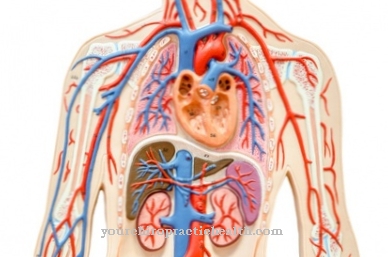The elevation is a form of movement of the shoulder and corresponds to a continuation of the abduction beyond a 90-degree angle. The eye is also capable of elevation, which is a lifting of the eyeball in adduction. Lesions of the motorized nerves can restrict the elevation.
What is the elevation?

Joints are flexible connections between two or more bones. Depending on their shape, all joints have certain axes of movement. Two movements are possible on each movement axis. The connected bones can move out of the neutral-zero position to a certain degree or be brought back into it.
One axis of motion is the axis of abduction and adduction. Abduction is a spreading movement. Adduction is attraction. For example, a person can move the arm into abduction and thereby lead his extremity away from his body.
The so-called elevation is an increase or continuation of the abduction. Only the arms can be brought to elevation. This is the case when a person abduces the arm and exceeds the horizontal angle of 90 degrees.
Only the shoulder joint offers the possibility of elevation. Occasionally, however, the term elevation is also used for eye movements. In this context, the elevation of the eyes corresponds to the upward movement of the eyeball.
Function & task
As a continuation of the abduction, the elevation is a type of splaying movement. While several joints of the body offer the possibility of abduction and adduction, elevation can only be accomplished in the shoulder joint. The shoulder joint is a ball joint that is considered to be the most flexible joint of its kind in the human body. Spreading movements in the sense of abduction are possible in this joint up to 90 degrees from the neutral-zero position. With the involvement of the shoulder girdle, the shoulder joints even allow abductions of up to 180 degrees.
The shoulder joints are guided and secured via the cuff-like muscles that connect to the joint. This so-called rotator cuff makes a significant contribution to joint stability. The tendons of the biceps brachii muscle and the deltoideus and pectoralis major muscles, together with other muscles, are involved in stabilizing and guiding the joint and its axes of movement.
Humans need the elevation movement, for example, to throw "off the shoulder". This movement is made possible by the interaction of the muscles mentioned and is also due to the high freedom of movement of the joint itself.
In connection with eye movement, elevation is the elevation of the eyeball in adduction. This elevation is made possible by the inferior oblique muscle. The ability of the eyes to elevate plays an important role for looking up, because since humans are eye-controlled, the individual partial movements and axes of movement of the eyes are very relevant for human evolution. Thanks to the mobility of their eyes, humans used to have a relatively reliable picture of dangers in their immediate surroundings. The individual axes of movement of the eyes have thus contributed significantly to the survival advantage of the human species.
You can find your medication here
➔ Medicines for painIllnesses & ailments
Both the elevation of the eyes and that of the shoulder can be restricted or even fail due to pathological processes. Since both types of elevation are performed by the aforementioned muscles, muscle diseases can make elevation difficult, for example.
In addition to muscle diseases, the elevation can also be difficult or even fail due to a lesion of the motor-supplied nerve tissue. The shoulder is motor innervated by the nerves of the brachial plexus. The relevant motor nerve for eye elevation is the oculomotor nerve.
Nerve damage can be traumatic, due to poisoning or malnutrition, tumor-related or, in the context of inflammation, of a bacterial or autoimmune nature.
While limitations in shoulder elevation can also be caused by a spinal cord infarction, strokes are also causal for disorders of eye elevation.
Joint diseases are also possible for disorders of shoulder elevation. One possible cause of the restriction can be osteoarthritis, for example. This is a wear and tear of the articular cartilage beyond the age-physiological degree, which is associated with pain and can lead to stiffening of the joint in the later stages.
Dislocations of the shoulder are also a common phenomenon that is due to the large range of motion of the joint. Colloquially, the joint dislocates during the dislocation. This means that the joint head is no longer in the joint socket, so that the usual movements are no longer possible. Dislocations can be congenital. Other congenital misalignments and malformations of the shoulder can also be associated with a disturbed ability to elevate.
























.jpg)



